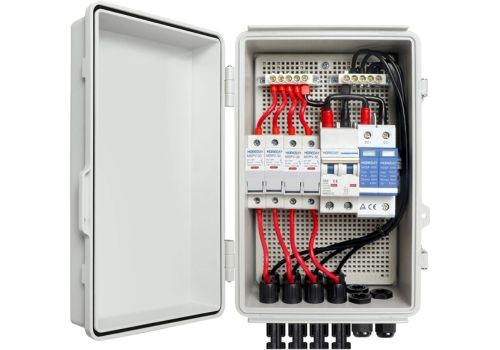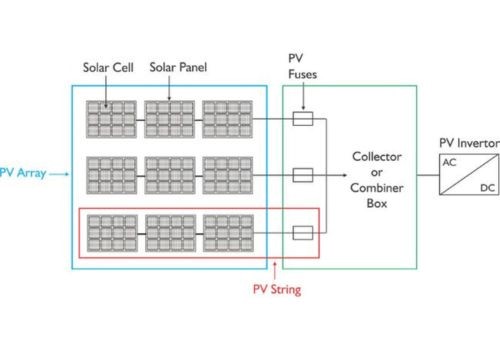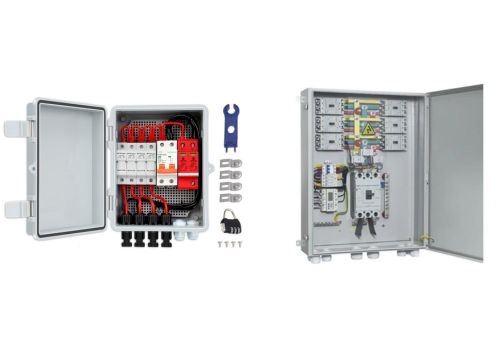Solar panels are gaining popularity around the globe as they transition to renewable energy. As their demand grows, the need for efficient and reliable system components becomes increasingly important. One such critical component is the combiner box.
Let’s dive right:
What is a Solar Combiner Box?
It is a common device in PV installation. It is an essential component in solar photovoltaic (PV) systems.
It is this combiner that integrates various outputs from string solar panels.
It is helpful in unifying all the output. Streamlining of connections become easy due to combine box. They significantly enhance the efficiency and safety of solar installations. They often include surge protection devices to safeguard the system from voltage spikes.

Difference between AC and DC Solar Combiner Box
Broadly, you can classify available solar combiner boxes depending on the type of current:
- AC combiner boxes
- DC combiner boxes
Let’s compare these two types of solar combiner boxes side-by-side:
|
The function of a Combiner Box
As the name indicates, it combines their outputs into one circuit. It also performs the following functions.
· Combining Solar Panel Strings
It organizes your wires. So wires appear neat, and easily identifiable. It also helpful in in avoiding tangling.
· Consolidate Incoming Power
The combiner box merges the electrical currents from multiple solar panel strings. This allows for a more straightforward connection to the inverter. Simply it means it convert the direct current to alternating current to use in home appliances and devices.
· Protection against Voltage Spikes
Combiner boxes provide protection to circuit breakers to avoid overvoltage. Some combiner boxes have features to streamline the overcurrent or overvoltage.
When is a Combiner Box Needed?
When your solar system has more than three strings of solar panels, it is indispensable for augmenting the protection of your inverter. Moreover, it provides a rapid shutdown in case of sudden voltage fluctuations. It protects your system.

Maintenance of Combiner Box
Maintaining a combiner box is necessary for the proper function of the system. If you ignore maintenance, its working will be affected. The following tips will help you maintain your combiner box.
- Regular Cleaning can enhance the life span of the combiner box. So keep it away from dust and debris.
- Check the connections inside the combiner box often. These connections must be tight and secure.
- Replace the broken connections and fuse.
- Invest in a millimeter to measure the voltage levels of the solar panels feeding into the combiner box.
- Enclosure boxes are also subject to wear and tear, so inspect the box’s seal and enclosure to ensure they remain watertight and dustproof.
How to Select the Best Combiner Box?
Selecting the best combiner box is not a big deal if you keep the following things in mind.

1. It should be High Quality
What do you mean by high Quality when it comes to combiner box sections? Combiner boxes must be made of robust materials or high-grade plastic, which can withstand harsh environments and high temperatures. They must also have a high Ingress Protection rating, indicating they are well-protected against dust and water. Moreover, they should be easy to install.
2. It must have Third-party Certification
You can check third-party certifications to learn about the robustness and quality assurance of the combiner b x. Third-party certifications also ensure that they have checked the combiner box before technical aspects and that it performs functions very well.
3. Consider Specific Technical Parameters
· Compatibility
Always ensure that the combiner box you are choosing is compatible with your systems. There are several inverters, including traditional string inverters, transformer less with dual channel MPP. So, check its computability with the inverter.
· Check Inputs and Outputs
You should know the number of solar panels strings.
Always choose a combiner box that can accommodate your system and has enough input and output strings.
Usually, combiner boxes are 30 N/A or 20 N/A. Here, 30 and 20 typically refer to the number of inputs (or strings) the box can handle, while “NA” might indicate a specific model or type within a manufacturer’s product line.
· Insulation, Surge Protection, and Fusing
High-quality combiner boxes have excellent insulation to prevent electrical shorts and other electrical hazards. It is important to ensure the box includes surge protection to safeguard against voltage spikes. Proper fusing within the box protects against overcurrent conditions.
· Monitoring Features
Modern combiner boxes have monitoring capabilities. System owners can track performance and identify issues with specific strings. Sometimes, the entire array has a problem and needs to be replaced.
· Price Consideration
When buying a solar combiner box, price should be the last consideration. You can find various combiner boxes with different price brackets.
Every box has some basic features, while some have modern features and show more compatibility, so these features can affect the price of a solar combiner box. Focus on the Quality and purpose of the combiner box instead of the price. You may find a cheaper combiner box, but it may lack safety features or not serve its purpose.
Conclusion
I hope you now have the answer to the question: What is a combiner box? The solar combiner box comes pre-configured, which makes it easy to install and use. It is available in a range of sizes. It is also easy to customize for your system.
The box offers many benefits, including protection equipment, cost reduction in labor and cabling, and wire organization. So, if you are looking for robust enclosures for combiner boxes or any kind of metal fabrication, thencontact KDM Fabrication.
More Resources:
What is a Junction Box – Source: KMDFAB
Electrical Enclosure – Source: KDMSTEEL
Solar Combiner – Source: MOSCOW
Solar Panel – Source: WIKIPEDIA




